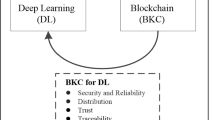Abstract
Businesses have classically put emphasis on human bonds related to their BM’s [www.conansence.org]. By the fast development of more sensoring, persuasive and virtual BMs increasingly run autonomously by machines, businesses should expect to be able to, build competence and thereby be capable in the future to innovated BM’s and operate BM’s in new types Business Model Ecosystems (BMES) (Lindgren and Rasmussen in J Multi BMI 4:1, 2016) in the future—where physical, digital and virtual BMES become integrated. This will investable open up to new multi business model potential but also require that businesses operate and innovate their multitudes of BM’s differently. BMES and BM’s (Lindgren in J Multi Bus Model Innov Technol 4:1, 2016; Lindgren and Rasmussen in J Multi Bus Model Innov Technol 1: 135, 2013) have for a longtime been based and built up with mainly human bond communication, but new technologies very much based on machine to human communication and machine to machine communication evolves and change the game of BMI with exponential speed. How will this change the game of Business Model Innovation (BMI) between humans, humans and machines and machines to machines. How will this evolvement influence businesses ability to “download”, “see”, “sense”, “relate” and “receive” and relate BM’s with their AS IS and TO BE BM’s. The paper addresses the exponential development of artificial intelligence technologies, persuasive technologies, virtual technologies and thereby increase the potential to create, capture, deliver, receive and consume physical, digital, persuasive and virtual BMs in Business model innovation and introduce a conceptual model to future business model innovation and operation.

(Adapted from Valter et al. [9])

Adapted from Valter et al. [9]

(Adapted from Valter et al. [9])

(Adapted from Valter et al. [9])

(Adapted from Valter et al. [9])
Similar content being viewed by others
References
Lindgren, P., & Rasmussen, O. H. (2016). The business model ecosystem. Journal of Multi BMI, 4, 1.
Lindgren, P. (2016). The business model relation axiom. Journal of Multi Business Model Innovation and Technology, 4, 1.
Lindgren, P., & Rasmussen, O. H. (2013). The business model cube. Journal of Multi Business Model Innovation and Technology, 1, 135.
Lindgren, P. (2017). Advanced business model innovation. Journal of Wireless Communication, 4, 71.
Prasad, R. (2016). Knowledge home. In International conference on advanced computer science and information systems (ICACSIS) (pp. 33–38). Malang: IEEE Explorer.
Lindgren, P. (2016). The business model ecosystem. Journal of Multi Business Model Innovation and Technology, 4(2), 1.
Lee, H. L. et al. (2016). Technological disruption and innovation in last-mile delivery. Stanford Business (pp. 1–26). Available at: https://www.gsb.stanford.edu/sites/gsb/files/publication-pdf/vcii-publicationtechnological-disruption-innovation-last-mile-delivery.pdf.
Valter, P., Lindgren, P., & Prasad, R. (2017). Artificial intelligence and deep learning in a world of humans and persuasive business models. In GWS 2017 Proceedings IEEE Explorer (in press).
Dashtban, M., & Balafar, M. (2017). Gene selection for microarray cancer classification using a new evolutionary method employing artificial intelligence concepts. Genomics, 109, 91–107.
Hassanalieragh, M., Page, A., Soyata, T., Sharma, G., Aktas, M., Mateos, G., Kantarci, B., & Andreescu, S. (2015). Health monitoring and management using internet-of-things (IoT) sensing with cloud-based processing: Opportunities and challenges. In 2015 IEEE 12th international conference on services computing (Scc 2015, pp 285–292).
Krasniqi, X., & Hajrizi, E. (2016). Use of IoT technology to drive the automotive industry from connected to full autonomous vehicles. IFAC Papersonline, 49, 269–274.
Ohshima, T., Satoh, K., Yamamoto, H., & Tamura, H. (1998). AR2 Hockey: A case study of collaborative augmented reality. In Proceedings of IEEE 1998 virtual reality annual international symposium (Cat. No. 98CB36180) (pp. 268–275).
Shatte, A., Holdsworth, J., & Lee, I. (2014). Hand-held mobile augmented reality for collaborative problem solving: A case study with sorting. In 2014 47th Hawaii international conference on system sciences (Hicss) (pp. 91–99).
Tu, M. R., Chang, Y. K. & Chen, Y. T. (2016). A context-aware recommender system framework for IoT based interactive digital signage in urban space. In Second international conference on IoT in urban space (Urb-Iot 2016) (pp. 39–42).
http://reedz.findtalk.biz/t107-human-computer-interactionhci-in-the-year-2020.
https://www.gatesnotes.com/Health/How-Virtual-Reality-Can-Help-Us-Fight-Viruses.
Liao, P. H., Hsu, P. T., Chu, W., & Chu, W. C. (2015). Applying artificial intelligence technology to support decision-making in nursing: A case study in Taiwan. Health Informatics Journal, 21, 137–148.
Valter, P., Lindgren, P., & Prasad, R. (2018). The consequences of artificial intelligence and deep learning in a world of persuasive business models. IEEE Aerospace and Electronic Systems Magazine (in press).
Author information
Authors and Affiliations
Corresponding author
Rights and permissions
About this article
Cite this article
Valter, P., Lindgren, P. & Prasad, R. Advanced Business Model Innovation Supported by Artificial Intelligence and Deep Learning. Wireless Pers Commun 100, 97–111 (2018). https://doi.org/10.1007/s11277-018-5612-x
Published:
Issue Date:
DOI: https://doi.org/10.1007/s11277-018-5612-x




